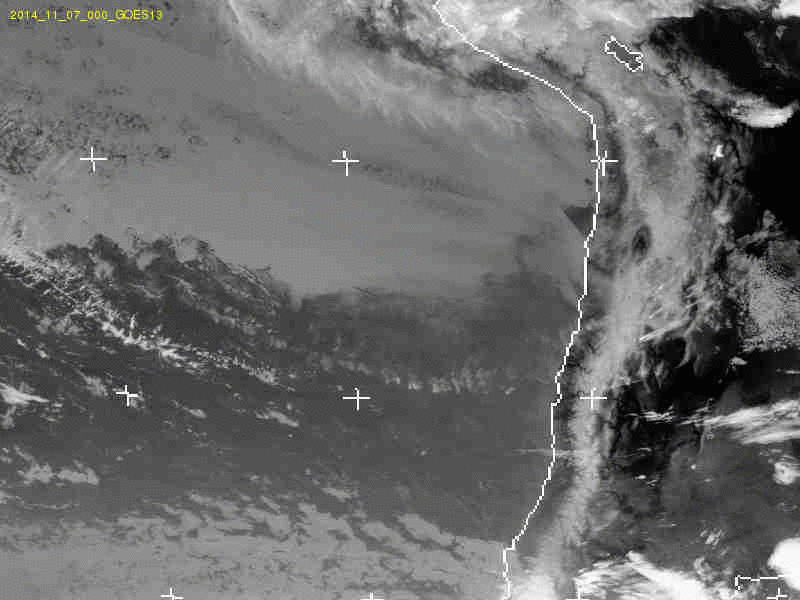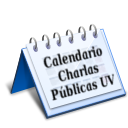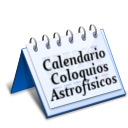December 15, 2015. IFA News
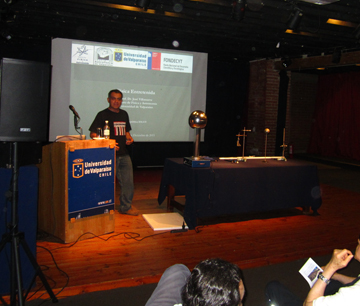 On monday December 14, IFA ended its 2015 period of Astronomy Public Talks for 2015, with the talk "Fun Physics", given by Dr. José Villanueva, Director for the Instituto de Física y Astronomía. These talks, given between April and December every year, are offered to the general public thanks to a permanent outreach project initiated in 2006 by Dr. Nikolaus Vogt, Investigator and professor of the Instituto.
On monday December 14, IFA ended its 2015 period of Astronomy Public Talks for 2015, with the talk "Fun Physics", given by Dr. José Villanueva, Director for the Instituto de Física y Astronomía. These talks, given between April and December every year, are offered to the general public thanks to a permanent outreach project initiated in 2006 by Dr. Nikolaus Vogt, Investigator and professor of the Instituto.
The talk described some basic principles pf classical physics, focusing on some of the basic characteristics of matter, atoms, neutrons, electrons, photons and their interactions,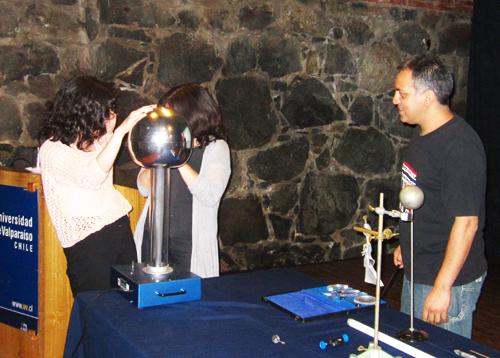 most specially those related to electrical, magnetic phenomena as well as optical geometry. The fun began with a practical demonstration of static electricity, with the help of two assistants, Sandra Lizana and Daniela Cerda, and the use of a device called Van de Graaff (electrostatic machine which uses a moving band to accumulate a great amount of electric charge on the surface of an empty metal sphere) and which allowed to demonstrate said electric charge, transferring it by contact, to the volunteers, producing static in their hair (hair standing on end). Then, by use of a laser the professor showed the basic principles of reflection and refraction of light, very much in evidence when making a light beam pass from one medium to another with different refraction coefficient (air/glass or air/water for example).
most specially those related to electrical, magnetic phenomena as well as optical geometry. The fun began with a practical demonstration of static electricity, with the help of two assistants, Sandra Lizana and Daniela Cerda, and the use of a device called Van de Graaff (electrostatic machine which uses a moving band to accumulate a great amount of electric charge on the surface of an empty metal sphere) and which allowed to demonstrate said electric charge, transferring it by contact, to the volunteers, producing static in their hair (hair standing on end). Then, by use of a laser the professor showed the basic principles of reflection and refraction of light, very much in evidence when making a light beam pass from one medium to another with different refraction coefficient (air/glass or air/water for example). 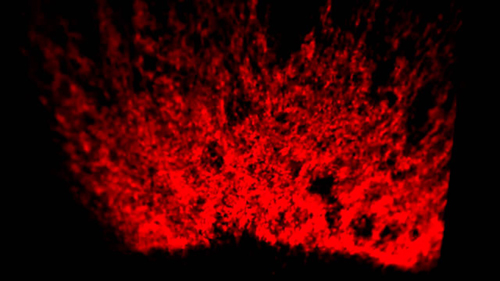 Another fun demonstration was the use of the laser light beam to make a homemade microscope, making the light fall on a drop of water, refracting it and observing the magnification of the microscopic particulate contained in the water, on a screen. The next UV Public Talk will be held on April 4, 2016, given by Dr. Verónica Motta, Director of the Centro de Astrofísica de Valparaíso, with the title "Einstein: el Señor de los Anillos". Images: Dr. Villanueva giving his talk, a demonstration on electrostatics, with D.Cerda and S.Lizana and an image produced by the laser microscope.
Another fun demonstration was the use of the laser light beam to make a homemade microscope, making the light fall on a drop of water, refracting it and observing the magnification of the microscopic particulate contained in the water, on a screen. The next UV Public Talk will be held on April 4, 2016, given by Dr. Verónica Motta, Director of the Centro de Astrofísica de Valparaíso, with the title "Einstein: el Señor de los Anillos". Images: Dr. Villanueva giving his talk, a demonstration on electrostatics, with D.Cerda and S.Lizana and an image produced by the laser microscope.
 December 7, 2015 IFA News.
December 7, 2015 IFA News.
Four milenium institutes highlighted, among them the Centro Interdisciplinario de Neurociencia de Valparaíso and the Millenium Institute of Astrophysics - MAS. Researchers from the Instituto de Física y Astronomía participate in MAS and the U. de Valparaiso is one of the participant organizations. MAS belongs to the top 20% of all organizations mentioned in the article with a Collaboration Score (CS) = 72.5. (Credits image: Nature journal)
Associated link: Opening Borders and Frontiers - Nature Journal.
December 1, 2015 IFA News.
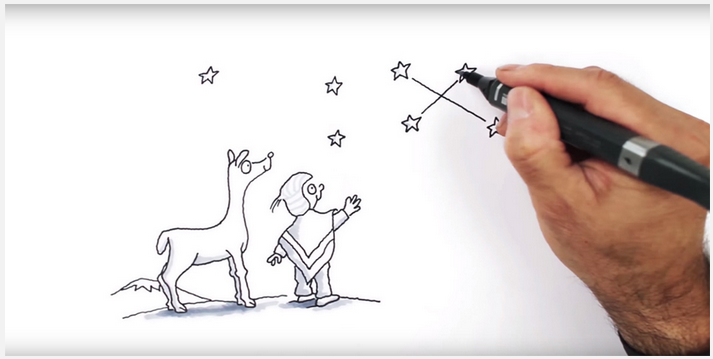 The Instituto Milenio de Astrofísica MAS launched two videos or "animates" last friday with the aim to bringing astronomy closer to children, a project initiated last July under the leadership of Mario Hamuy (Premio Nacional de Ciencias Exactas 2015) and the popular cartoonist "Guille", and in which our researcher and member of IFA Juan Carlos Beamin is an enthusiastic participant. These videos bring together art and astronomy, by means of drawings and music, so as to explain astrophysical concepts in a way easier to understand, thereby making them accesible to children and to anyone interested in learning about this fascinating science. Image: a photograph of part of one of the videos.
The Instituto Milenio de Astrofísica MAS launched two videos or "animates" last friday with the aim to bringing astronomy closer to children, a project initiated last July under the leadership of Mario Hamuy (Premio Nacional de Ciencias Exactas 2015) and the popular cartoonist "Guille", and in which our researcher and member of IFA Juan Carlos Beamin is an enthusiastic participant. These videos bring together art and astronomy, by means of drawings and music, so as to explain astrophysical concepts in a way easier to understand, thereby making them accesible to children and to anyone interested in learning about this fascinating science. Image: a photograph of part of one of the videos.
Associated link: Noticia La Tercera
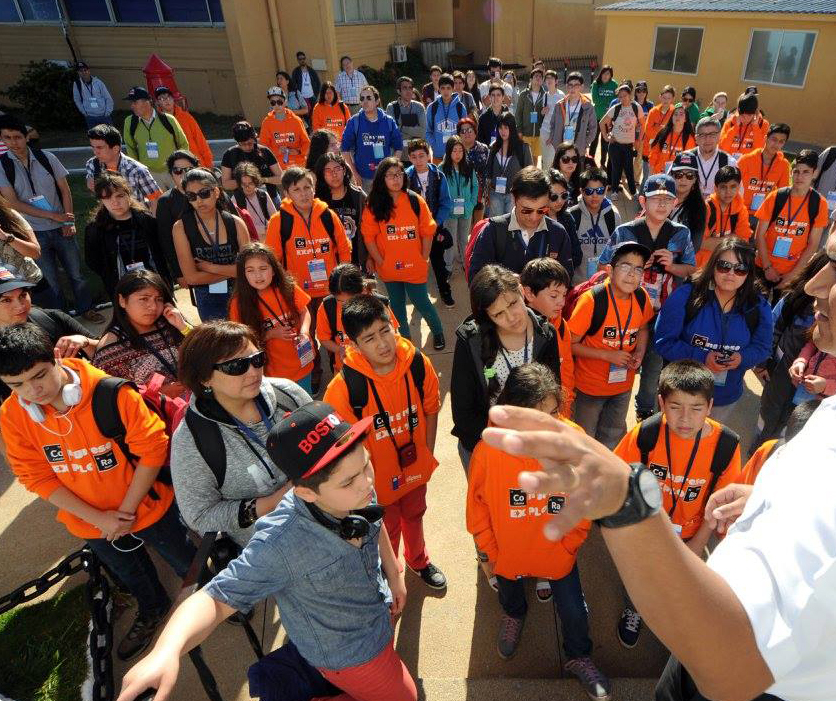
November 30, 2015 IFA News
On November 25-26 last, Valparaíso hosted the XVI Congreso Nacional Escolar de Ciencia y Tecnología organized by Explora. This year, 110 students participated in this initiative with their research projects. The IFA member and researchers, Amelia Bayo and Sebastian Ramirez participated as evaluators in an experience they qualified as very enriching and, most of all, very relevant, when we considering the great level of compromise on behalf of the students and their interest for science, with that curiosity that characterizes the newer generations (Image credits Explora Conicyt)
More information on this competition can be found at the oficial webpage of the event
November 25, 2015 IFA News
 Dr. Sebastian Ramirez, IFA postdoc, enchanted the public present at his talk in the Public Library of Antofagasta, II Region of Chile, yesterday November 24, titled "A Superstar for Superman?". In his talk he gathered the clues that appear in the many stories about this super heroe, who presumably arrived on Earth escaping from a planet destroyed by an exploding red star, and using them to discover the possible culprit, examining two types of stars that could be responsible for that scenario, and using the astronomy information we currently know about such objects to finally answer the question: "Were supergiant red stars o giant red stars responsible?". Dr. Ramirez is Postdoctoral investigator at hte Instituto de Fisica y Astronomia of the UNiversidad de Valparaíso since 2013. I January 2016 he will give the talk once again, this time i Valparaíso, hosted by the Sociedad Astronómica de Valparaiso y Viña del Mar-Saval, open to all public. The notice will be put up on that institution´s website very soon.
Dr. Sebastian Ramirez, IFA postdoc, enchanted the public present at his talk in the Public Library of Antofagasta, II Region of Chile, yesterday November 24, titled "A Superstar for Superman?". In his talk he gathered the clues that appear in the many stories about this super heroe, who presumably arrived on Earth escaping from a planet destroyed by an exploding red star, and using them to discover the possible culprit, examining two types of stars that could be responsible for that scenario, and using the astronomy information we currently know about such objects to finally answer the question: "Were supergiant red stars o giant red stars responsible?". Dr. Ramirez is Postdoctoral investigator at hte Instituto de Fisica y Astronomia of the UNiversidad de Valparaíso since 2013. I January 2016 he will give the talk once again, this time i Valparaíso, hosted by the Sociedad Astronómica de Valparaiso y Viña del Mar-Saval, open to all public. The notice will be put up on that institution´s website very soon.
Associated link: News posted on the Unidad de Astronomía de la Universidad de Antofagasta website
November 23, 2015. IFA News.
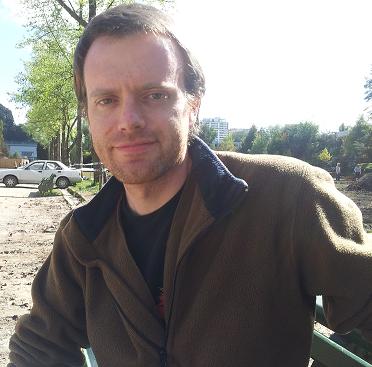 The Proyecto Fondecyt 79150053, of three years duration, titled, "FORTALECIMIENTO DE LA FÍSICA Y LA COMPUTACIÓN CIENTÍFICA EN EL INSTITUTO DE FÍSICA Y ASTRONOMÍA" winner in the Concurso Inserción en la Academia de CONICYT 2015, was awarded to Professor and investigator at IFA, Dr. Jose Villanueva (PI) together with Dr. Victor Cárdenas. The project contemplates the participation of Dr. Graeme Candlish, of scottish nationality, who will come to Valparaiso to reinforce the Academic Undergraduate Program in the Instituto de Fisica y Astronomia regarding the Licenciatura en Física career in its three specialties: Astronomy, Atmnospheric Sciences, and Scientifric Computing. In the image, Dr. Graeme Candlish
The Proyecto Fondecyt 79150053, of three years duration, titled, "FORTALECIMIENTO DE LA FÍSICA Y LA COMPUTACIÓN CIENTÍFICA EN EL INSTITUTO DE FÍSICA Y ASTRONOMÍA" winner in the Concurso Inserción en la Academia de CONICYT 2015, was awarded to Professor and investigator at IFA, Dr. Jose Villanueva (PI) together with Dr. Victor Cárdenas. The project contemplates the participation of Dr. Graeme Candlish, of scottish nationality, who will come to Valparaiso to reinforce the Academic Undergraduate Program in the Instituto de Fisica y Astronomia regarding the Licenciatura en Física career in its three specialties: Astronomy, Atmnospheric Sciences, and Scientifric Computing. In the image, Dr. Graeme Candlish
Associated link: List of winners
November 19, 2015 IFA News.
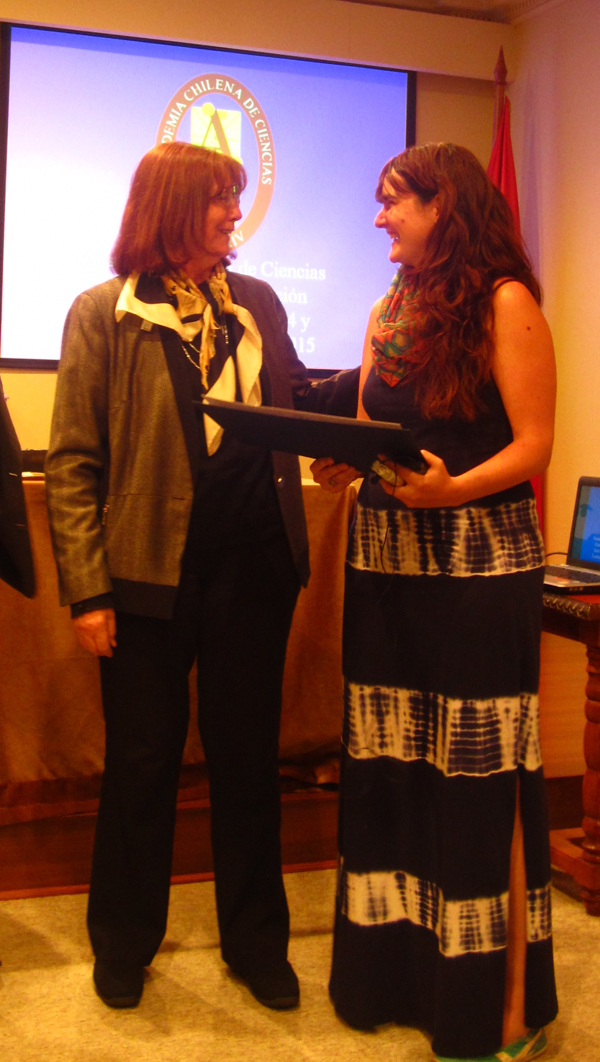 In Santiago, November 19, wednesday last, our investigator and member of the Instituto de Fisica y Astronomia, Dr. Amelia Bayo, received the "Premio Excelencia Científica Adelina Gutiérrez, 2015" prize, awarded to outstanding young investigators under 40 years of age. Dr. Maria Teresa Ruiz, Vicepresident of the Academia Chilena de Ciencias, herself winner of the "Premio Nacional de Ciencias Exactas" of 1997, congratulated Dr. Bayo on her achievements, who from a mathematics formation gravitated towards numbers and their use in astrophysics, where today this knwoledge is ndispensable for processing the great volumes of data resulting from observations done with current big Telescopes (ALMA, for example) and those being constructed.
In Santiago, November 19, wednesday last, our investigator and member of the Instituto de Fisica y Astronomia, Dr. Amelia Bayo, received the "Premio Excelencia Científica Adelina Gutiérrez, 2015" prize, awarded to outstanding young investigators under 40 years of age. Dr. Maria Teresa Ruiz, Vicepresident of the Academia Chilena de Ciencias, herself winner of the "Premio Nacional de Ciencias Exactas" of 1997, congratulated Dr. Bayo on her achievements, who from a mathematics formation gravitated towards numbers and their use in astrophysics, where today this knwoledge is ndispensable for processing the great volumes of data resulting from observations done with current big Telescopes (ALMA, for example) and those being constructed. 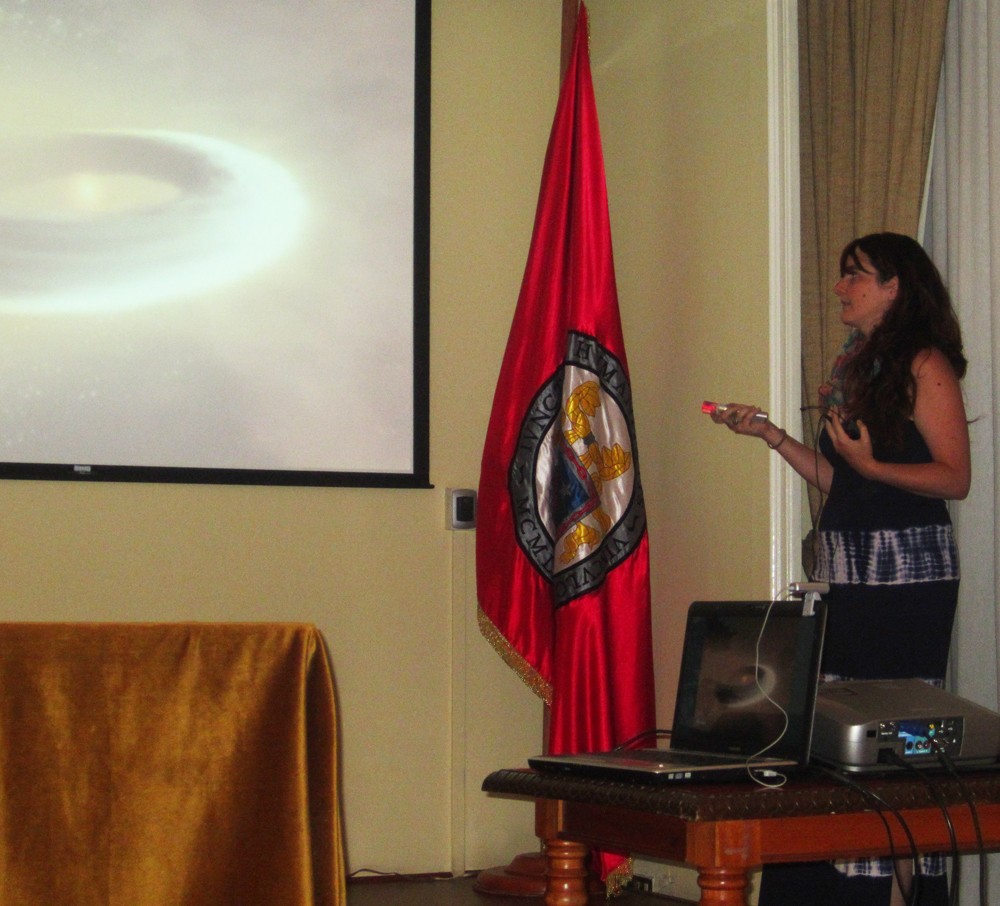 Dr. Ruiz went on to note that in spite of Dr. Bayo´s young age, she already stands out in lieu of her extense and interesting research area around low mass stars, brown dwarfs, astrostatistics, and, not least, her efforts to do outreach in a science that has become very important to Chile. Dr. Bayo herself then gave a brief talk about her "Journey from Mathematics to Brown Dwarfs", these last only one aspect of her varied and interesting research area. The ceremony (including prizes to two other researchers, for "The Best PhD Thesis, 2014" and a "Special Prize") ended with a celebration cocktail. In the images. Dr. Bayo receives her prize from Dr. Maria Teresa Ruiz, and giving her talk to those who attended the ceremony
Dr. Ruiz went on to note that in spite of Dr. Bayo´s young age, she already stands out in lieu of her extense and interesting research area around low mass stars, brown dwarfs, astrostatistics, and, not least, her efforts to do outreach in a science that has become very important to Chile. Dr. Bayo herself then gave a brief talk about her "Journey from Mathematics to Brown Dwarfs", these last only one aspect of her varied and interesting research area. The ceremony (including prizes to two other researchers, for "The Best PhD Thesis, 2014" and a "Special Prize") ended with a celebration cocktail. In the images. Dr. Bayo receives her prize from Dr. Maria Teresa Ruiz, and giving her talk to those who attended the ceremony
Associated links: UV News - News from the Academia de Ciencias - Prize announcement for Dr. Bayo
Noviembre 11, 2015. Noticias IFA
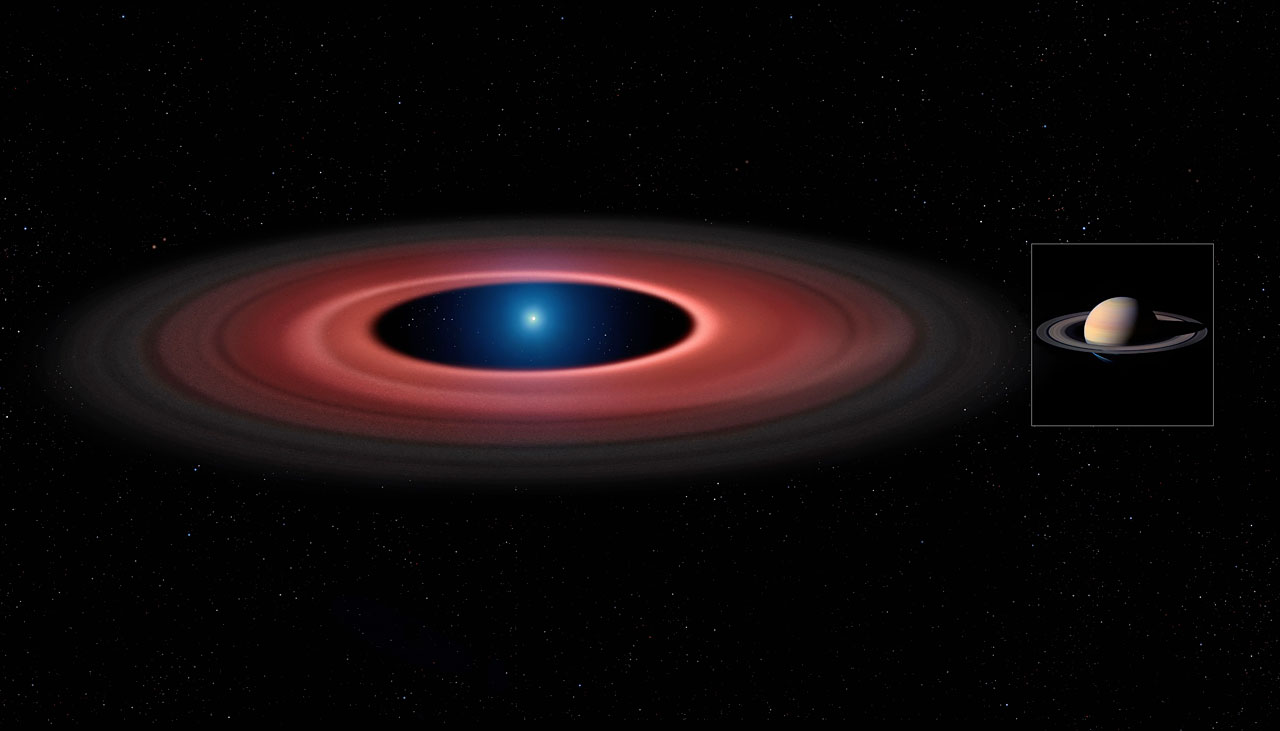 With that title, ESO publishes Science Release eso1544 explaning how VLT maps out the remains of a white dwarf’s meal. The remains of a fatal interaction between a dead star and its asteroid supper have been studied in detail for the first time by an international team of astronomers using the Very Large Telescope at ESO’s Paranal Observatory in Chile. This gives a glimpse of the far-future fate of the Solar System. The team led by Christopher Manser, a PhD student at the University of Warwick in the United Kingdom, and in which Steven Parsons of IFA participated in the resulting paper, used data from ESO’s Very Large Telescope (VLT) and other observatories to study the shattered remains of an asteroid around a stellar remnant using a technique called Doppler tomography — similar in principle to medical tomographic scans of the human body — which allowed them to map out in detail the structure of the glowing gaseous remains of the dead star’s meal orbiting J1228+1040 for the first time — a white dwarf called SDSS J1228+1040. Using several instruments, including the Ultraviolet and Visual Echelle Spectrograph (UVES) and X-shooter, both attached to the VLT, the team obtained detailed observations of the light coming from the white dwarf and its surrounding material over an unprecedented period of twelve years between 2003 and 2015. Observations over periods of years were needed to probe the system from multiple viewpoints [2]. “The image we get from the processed data shows us that these systems are truly disc-like, and reveals many structures that we cannot detect in a single snapshot,” explained lead author Christopher Manser. Steven Parsons participated in the pulished paper. Image: An artist's impression of the debris disc around the white dwarf SDSS J1228+1040 (left) at the same scale as Saturn and its rings (right). While the white dwarf in SDSS J1228+1040 has about seven times smaller diameter than Saturn, it has a mass 2500 times greater. (image credits: ESO)
With that title, ESO publishes Science Release eso1544 explaning how VLT maps out the remains of a white dwarf’s meal. The remains of a fatal interaction between a dead star and its asteroid supper have been studied in detail for the first time by an international team of astronomers using the Very Large Telescope at ESO’s Paranal Observatory in Chile. This gives a glimpse of the far-future fate of the Solar System. The team led by Christopher Manser, a PhD student at the University of Warwick in the United Kingdom, and in which Steven Parsons of IFA participated in the resulting paper, used data from ESO’s Very Large Telescope (VLT) and other observatories to study the shattered remains of an asteroid around a stellar remnant using a technique called Doppler tomography — similar in principle to medical tomographic scans of the human body — which allowed them to map out in detail the structure of the glowing gaseous remains of the dead star’s meal orbiting J1228+1040 for the first time — a white dwarf called SDSS J1228+1040. Using several instruments, including the Ultraviolet and Visual Echelle Spectrograph (UVES) and X-shooter, both attached to the VLT, the team obtained detailed observations of the light coming from the white dwarf and its surrounding material over an unprecedented period of twelve years between 2003 and 2015. Observations over periods of years were needed to probe the system from multiple viewpoints [2]. “The image we get from the processed data shows us that these systems are truly disc-like, and reveals many structures that we cannot detect in a single snapshot,” explained lead author Christopher Manser. Steven Parsons participated in the pulished paper. Image: An artist's impression of the debris disc around the white dwarf SDSS J1228+1040 (left) at the same scale as Saturn and its rings (right). While the white dwarf in SDSS J1228+1040 has about seven times smaller diameter than Saturn, it has a mass 2500 times greater. (image credits: ESO)
Associated links: ESO Science Release - Scientific Paper
November 4, 2015 IFA News.
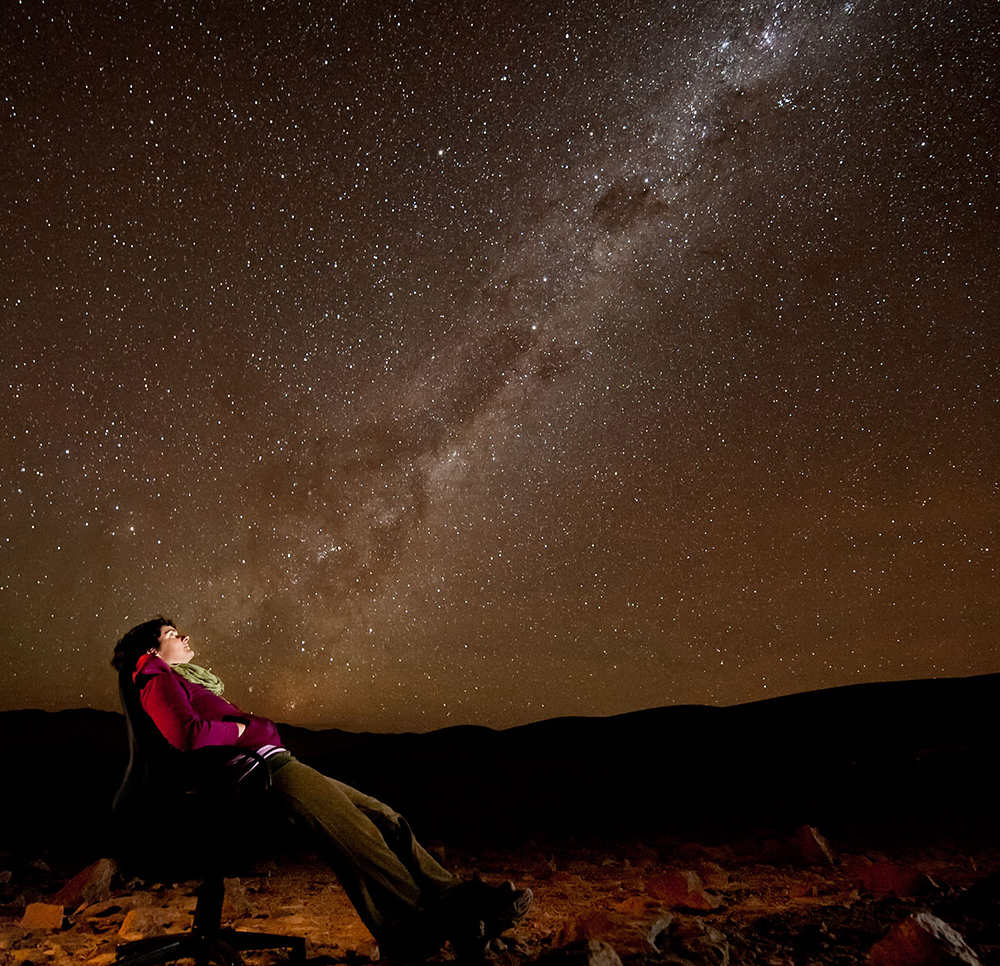 With the aim to contributing to the furthering of science in the country and incentivating investigators in science, the Academia Chilena de Ciencias created the Prize for Academic Excellency "ACADEMIA CHILENA DE CIENCIAS" for young investigators under 40 years of age. The investigator, Dra. Amelia Bayo, Licenciada en Matemáticas, Doctor en Astrofísica y Cosmología of the Universidad Autónoma de Madrid, and member of IFA has been selected by the jury for the Premio Excelencia Científica Adelina Gutiérrez, 2015" awarded by the Academy. The prize will be given to Dr. Bayo in a ceremony to be held next November 18 at the Academia de Ciencias, Santiago de Chile. In the image, Dr. Bayo under the Desert of Atacama's night sky, while working at ESO/Paranal. (Image credits: ESO/Max Alexander)
With the aim to contributing to the furthering of science in the country and incentivating investigators in science, the Academia Chilena de Ciencias created the Prize for Academic Excellency "ACADEMIA CHILENA DE CIENCIAS" for young investigators under 40 years of age. The investigator, Dra. Amelia Bayo, Licenciada en Matemáticas, Doctor en Astrofísica y Cosmología of the Universidad Autónoma de Madrid, and member of IFA has been selected by the jury for the Premio Excelencia Científica Adelina Gutiérrez, 2015" awarded by the Academy. The prize will be given to Dr. Bayo in a ceremony to be held next November 18 at the Academia de Ciencias, Santiago de Chile. In the image, Dr. Bayo under the Desert of Atacama's night sky, while working at ESO/Paranal. (Image credits: ESO/Max Alexander)
Noviembre 3, 2015. Noticias IFA.
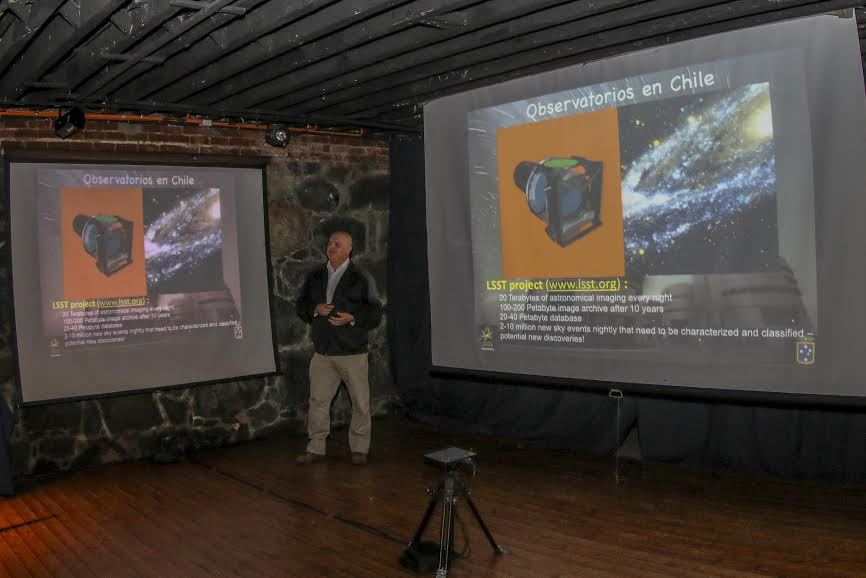 On November 2, the Sala Ruben Dario del Centro de Extensión de la U. de Valparaíso, a place that has welcomed a public passionate about astronomy on every first Monday of the month between April and December for almost ten years, celebrated 100 Talks on this lovely science among the interested community. Among those present were the Rector of the Universidad de Valparaíso, Mr. Aldo Valle, the Director of the Centro de Extensión, Mr. David Carrillo, the Director of the Dirección de Investigación, Dr. Adrián Palacios, the Dean of the Facultad de Ciencias, Dr. Juan Kuznar, Director of División Académica, Mr. José Miguel Salazar, and the Director for the Centro de Astrofísica, Dr. Verónica Motta. The event began with a presentation by the author of this initiative, Dr. Nikolaus Vogt, professor and investigator for IFA, giving an account of how it all began, remembering that very first talk, on May 8, 2006, and then the results of this effort over almost ten years. He gave the public an idea of the astronomers and other people who participated in this project, their affiliations, academic degree, and nationality, all whom collaborated generously with talks on some specific area in astronomy, ranging from planetary, galactic, extragalactic astronomy and also cosmology, not leaving out music of the stars, and exotic objects from our galaxy and the profound universe, bio-astronomy, archeo-astronomy, amateur astronomy and its collaboration in the work of professionals. Also, and most important, he mentioned the two scientific panels which were undertaken to invite the public to learn about how science is done. He ended his intervention by presenting and welcoming Dr. Patricia Arévalo, professor and investigator of IFA, who will share and undertake the continuity of this astronomy outreach program at the Centro de Extensión. The Director del Centro de Extension, Mr. David Carrillo then thanked professor Vogt for his work, highlighting the importance of this cycle within the UV, mentioning some new ideas to further it in the future. Then, the Dean of the Facultad de Ciencias, Dr. Juan Kuznar took the stand and gave an account of a less known, but not less important, aspect of astronomy, namely that associated to biology and chemistry and how the new observatories will be able to tackle them with better definition in the near future, exploring bio-markers of new worlds with the aim to studying their possibilities for sustaining life. Finally, the much awaited 100 th talk took place, given by Dr. Michel Curé, professor and investigator from IFA, who gave an animated and dynamic description of Chile today, during 50 minutes, regarding its academic and instrumental aspect in astronomy, most importantly the observatories and their presence in the world, and their light collecting capacity. He took those present on a journey into the future, by means of attractive videos, showing the new observatories that are already being installed and those projected to be built in the north of Chile, and evidencing how these will then represent 2/3 of the all the worlds optical and near infrarred light collecting power,a relevant fact for the development in Chile of Astronomy.
On November 2, the Sala Ruben Dario del Centro de Extensión de la U. de Valparaíso, a place that has welcomed a public passionate about astronomy on every first Monday of the month between April and December for almost ten years, celebrated 100 Talks on this lovely science among the interested community. Among those present were the Rector of the Universidad de Valparaíso, Mr. Aldo Valle, the Director of the Centro de Extensión, Mr. David Carrillo, the Director of the Dirección de Investigación, Dr. Adrián Palacios, the Dean of the Facultad de Ciencias, Dr. Juan Kuznar, Director of División Académica, Mr. José Miguel Salazar, and the Director for the Centro de Astrofísica, Dr. Verónica Motta. The event began with a presentation by the author of this initiative, Dr. Nikolaus Vogt, professor and investigator for IFA, giving an account of how it all began, remembering that very first talk, on May 8, 2006, and then the results of this effort over almost ten years. He gave the public an idea of the astronomers and other people who participated in this project, their affiliations, academic degree, and nationality, all whom collaborated generously with talks on some specific area in astronomy, ranging from planetary, galactic, extragalactic astronomy and also cosmology, not leaving out music of the stars, and exotic objects from our galaxy and the profound universe, bio-astronomy, archeo-astronomy, amateur astronomy and its collaboration in the work of professionals. Also, and most important, he mentioned the two scientific panels which were undertaken to invite the public to learn about how science is done. He ended his intervention by presenting and welcoming Dr. Patricia Arévalo, professor and investigator of IFA, who will share and undertake the continuity of this astronomy outreach program at the Centro de Extensión. The Director del Centro de Extension, Mr. David Carrillo then thanked professor Vogt for his work, highlighting the importance of this cycle within the UV, mentioning some new ideas to further it in the future. Then, the Dean of the Facultad de Ciencias, Dr. Juan Kuznar took the stand and gave an account of a less known, but not less important, aspect of astronomy, namely that associated to biology and chemistry and how the new observatories will be able to tackle them with better definition in the near future, exploring bio-markers of new worlds with the aim to studying their possibilities for sustaining life. Finally, the much awaited 100 th talk took place, given by Dr. Michel Curé, professor and investigator from IFA, who gave an animated and dynamic description of Chile today, during 50 minutes, regarding its academic and instrumental aspect in astronomy, most importantly the observatories and their presence in the world, and their light collecting capacity. He took those present on a journey into the future, by means of attractive videos, showing the new observatories that are already being installed and those projected to be built in the north of Chile, and evidencing how these will then represent 2/3 of the all the worlds optical and near infrarred light collecting power,a relevant fact for the development in Chile of Astronomy. 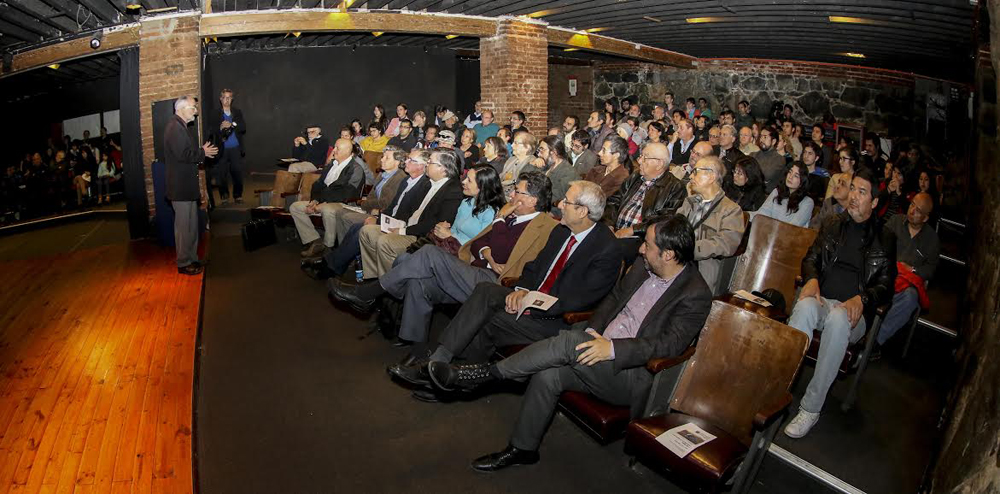 Somewhat closer to home, Valparaíso, Dr. Curé gave an account of that vision held by only six people, way back in 2006, and who created what today is known as the Instituto de Fisica y Astronomía, IFA which grew at an exponential rate, and which today is has no less than 18 professors with a PhD degree, undertaking cutting edge research, with two postgraduate programs, Master and PhD in Astrophysics, each one accredited for the maximum period allowable. He thanked the support given by the Rector and directors of the university who were able to envision this very same dream of astronomy for the V Region and which today offers an exceptional future not only for the University of Valparaíso but establishes it as pioneer in astronomy in the region. The event closed with a celebration cocktail in which the attending public were able to talk directly with Drs. Curé and Vogt and other participants of this celebration of 100 talks doing outreach in astronomy to the public, at no cost and of very high academic level. (Credits images: Facultad de Ciencias Journalist Pamela Simonetti, and her team). Associated link: Dr. Nikolaus Vogt´s presentation, .pdf file
Somewhat closer to home, Valparaíso, Dr. Curé gave an account of that vision held by only six people, way back in 2006, and who created what today is known as the Instituto de Fisica y Astronomía, IFA which grew at an exponential rate, and which today is has no less than 18 professors with a PhD degree, undertaking cutting edge research, with two postgraduate programs, Master and PhD in Astrophysics, each one accredited for the maximum period allowable. He thanked the support given by the Rector and directors of the university who were able to envision this very same dream of astronomy for the V Region and which today offers an exceptional future not only for the University of Valparaíso but establishes it as pioneer in astronomy in the region. The event closed with a celebration cocktail in which the attending public were able to talk directly with Drs. Curé and Vogt and other participants of this celebration of 100 talks doing outreach in astronomy to the public, at no cost and of very high academic level. (Credits images: Facultad de Ciencias Journalist Pamela Simonetti, and her team). Associated link: Dr. Nikolaus Vogt´s presentation, .pdf file
November 2, 2015 IFA News
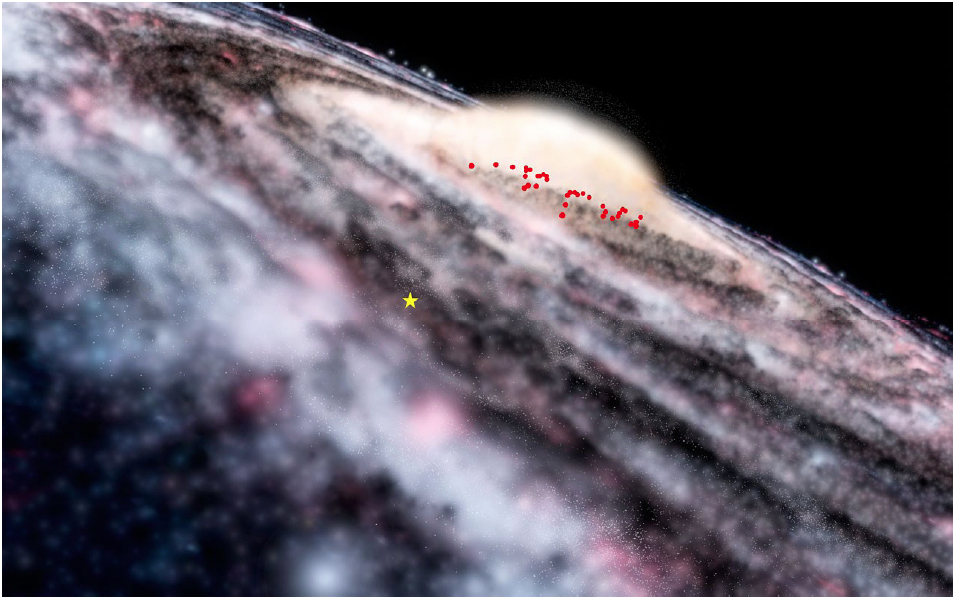 Astronomers using the VISTA telescope at ESO’s Paranal Observatory have discovered a previously unknown component of the Milky Way. By mapping out the locations of a class of stars that vary in brightness called Cepheids, a disc of young stars buried behind thick dust clouds in the central bulge has been found. The Vista Variables in the Vía Láctea Survey (VVV) [1] ESO public survey is using the VISTA telescope at the Paranal Observatory to take multiple images at different times of the central parts of the galaxy at infrared wavelengths [2]. It is discovering huge numbers of new objects, including variable stars, clusters and exploding stars (eso1101, eso1128, eso1141). A team of astronomers, led by Istvan Dékány of the Pontificia Universidad Católica de Chile, has now used data from this survey, taken between 2010 and 2014, to make a remarkable discovery — a previously unknown component of our home galaxy, the Milky Way. “The central bulge of the Milky Way is thought to consist of vast numbers of old stars. But the VISTA data has revealed something new — and very young by astronomical standards!” says Istvan Dékány, lead author of the new study. Analysing data from the survey, the astronomers found 655 candidate variable stars of a type called Cepheids. These stars expand and contract periodically, taking anything from a few days to months to complete a cycle and changing significantly in brightness as they do so. The time taken for a Cepheid to brighten and fade again is longer for those that are brighter and shorter for the dimmer ones. This remarkably precise relationship, which was discovered in 1908 by American astronomer Henrietta Swan Leavitt, makes the study of Cepheids one of the most effective ways to measure the distances to, and map the positions of, distant objects in the Milky Way and beyond.
Astronomers using the VISTA telescope at ESO’s Paranal Observatory have discovered a previously unknown component of the Milky Way. By mapping out the locations of a class of stars that vary in brightness called Cepheids, a disc of young stars buried behind thick dust clouds in the central bulge has been found. The Vista Variables in the Vía Láctea Survey (VVV) [1] ESO public survey is using the VISTA telescope at the Paranal Observatory to take multiple images at different times of the central parts of the galaxy at infrared wavelengths [2]. It is discovering huge numbers of new objects, including variable stars, clusters and exploding stars (eso1101, eso1128, eso1141). A team of astronomers, led by Istvan Dékány of the Pontificia Universidad Católica de Chile, has now used data from this survey, taken between 2010 and 2014, to make a remarkable discovery — a previously unknown component of our home galaxy, the Milky Way. “The central bulge of the Milky Way is thought to consist of vast numbers of old stars. But the VISTA data has revealed something new — and very young by astronomical standards!” says Istvan Dékány, lead author of the new study. Analysing data from the survey, the astronomers found 655 candidate variable stars of a type called Cepheids. These stars expand and contract periodically, taking anything from a few days to months to complete a cycle and changing significantly in brightness as they do so. The time taken for a Cepheid to brighten and fade again is longer for those that are brighter and shorter for the dimmer ones. This remarkably precise relationship, which was discovered in 1908 by American astronomer Henrietta Swan Leavitt, makes the study of Cepheids one of the most effective ways to measure the distances to, and map the positions of, distant objects in the Milky Way and beyond.
But there is a catch — Cepheids are not all the same — they come in two main classes, one much younger than the other. Out of their sample of 655 the team identified 35 stars as belonging to a sub-group called classical Cepheids — young bright stars, very different from the usual, much more elderly, residents of the central bulge of the Milky Way. The team gathered information on the brightness, pulsation period, and deduced the distances of these 35 classical Cepheids. Their pulsation periods, which are closely linked to their age, revealed their surprising youth. “All of the 35 classical Cepheids discovered are less than 100 million years old. The youngest Cepheid may even be only around 25 million years old, although we cannot exclude the possible presence of even younger and brighter Cepheids,” explains the study’s second author Dante Minniti, of the Universidad Andres Bello, Santiago, Chile. The ages of these classical Cepheids provide solid evidence that there has been a previously unconfirmed, continuous supply of newly formed stars into the central region of the Milky Way over the last 100 million years. But, this wasn’t to be the only remarkable discovery from the survey’s dataset. Mapping the Cepheids that they discovered, the team traced an entirely new feature in the Milky Way — a thin disc of young stars across the galactic bulge. This new component to our home galaxy had remained unknown and invisible to previous surveys as it was buried behind thick clouds of dust. Its discovery demonstrates the unique power of VISTA, which was designed to study the Milky Way’s deep structures by wide-field, high-resolution imaging at infrared wavelengths.
“This study is a powerful demonstration of the unmatched capabilities of the VISTA telescope for probing extremely obscured galactic regions that cannot be reached by any other current or planned surveys,” remarks Dékány. “This part of the galaxy was completely unknown until our VVV survey found it!” adds Minniti. Further investigations are now needed to assess whether these Cepheids were born close to where they are now, or whether they originate from further out. Understanding their fundamental properties, interactions, and evolution is key in the quest to understand the evolution of the Milky Way, and the process of galaxy evolution as a whole.
The team is composed of I. Dékány (Instituto Milenio de Astrofísica, Santiago, Chile; Pontificia Universidad Católica de Chile, Santiago, Chile), D. Minniti (Universidad Andres Bello, Santiago, Chile; Instituto Milenio de Astrofísica MAS and Basal CATA, Santiago, Chile; and Vatican Observatory, Vatican City State), D. Majaess (Saint Mary’s University, Halifax, Nova Scotia, Canada; Mount Saint Vincent University, Halifax, Nova Scotia, Canada) , M. Zoccali (Pontificia Universidad Católica de Chile, Santiago, Chile; Instituto Milenio de Astrofísica, Santiago, Chile), G. Hajdu (Pontificia Universidad Católica de Chile, Santiago, Chile; Instituto Milenio de Astrofísica, Santiago, Chile), J. Alonso-García (Universidad de Antofagasta, Antofagasta, Chile; Instituto Milenio de Astrofísica, Santiago, Chile), M. Catelan (Pontificia Universidad Católica de Chile, Santiago, Chile; Instituto Milenio de Astrofísica, Santiago, Chile), W. Gieren (Universidad de Concepción, Concepción, Chile; Instituto Milenio de Astrofísica, Santiago, Chile) and J. Borissova (Universidad de Valparaíso, Valparaíso, Chile; Instituto Milenio de Astrofísica, Santiago, Chile).
Image credits and source: ESO, European Southern Observatory-science release eso1542es-cl
October 21, 2015 IFA News.
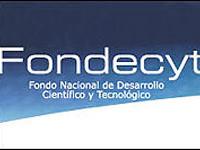 Successful applicants to the Fondecyt national postdoctoral grant will join our Institute in the next few months, coming from Chile, México, Belgium, India and Spain. Their research projects will cover a wide range of topics, including dwarf stars, planetary nebulae, black hole accretion, observational cosmology and cosmological simulations. Four out of the five new postdocs were sponsored by the young faculty members that joined our Institute in 2014, evidencing the multiplicative effect of the rapid growth of the Institute. The new Fondecyt postdoctoral fellows joining IFA amount to 5 out of a total of 11 successful applicants sponsored by the University of Valparaiso this year.
Successful applicants to the Fondecyt national postdoctoral grant will join our Institute in the next few months, coming from Chile, México, Belgium, India and Spain. Their research projects will cover a wide range of topics, including dwarf stars, planetary nebulae, black hole accretion, observational cosmology and cosmological simulations. Four out of the five new postdocs were sponsored by the young faculty members that joined our Institute in 2014, evidencing the multiplicative effect of the rapid growth of the Institute. The new Fondecyt postdoctoral fellows joining IFA amount to 5 out of a total of 11 successful applicants sponsored by the University of Valparaiso this year.
The new investigators are Drs. Alba Aller, Juan Magaña, Santanu Mondal, Alejandra Muñoz and Joris Vos.
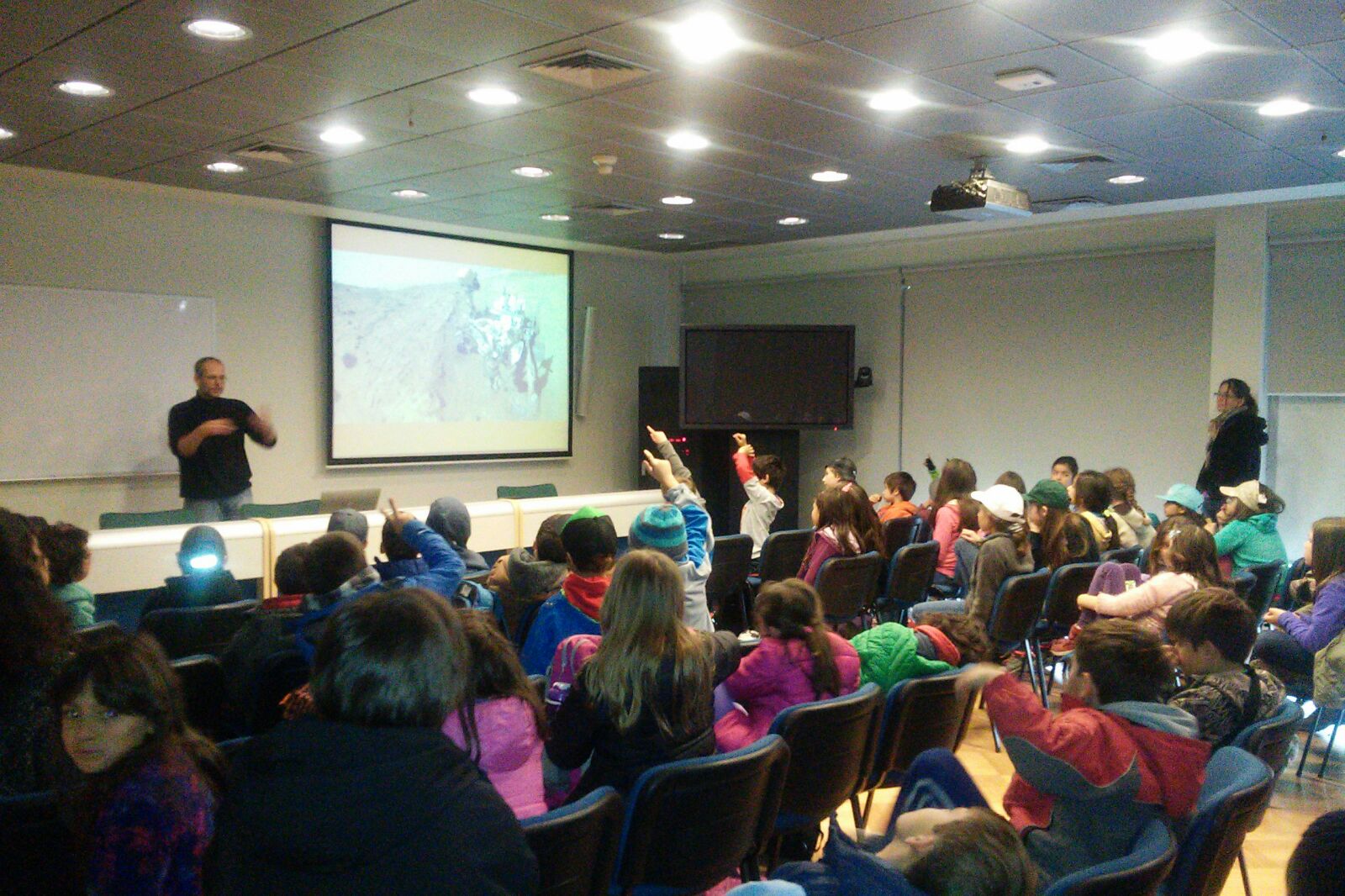 October 20, 2015 IFA News
October 20, 2015 IFA News
On thursday October 15, professor Claus Tappert from IFA gave an astronomy talk for students of Third Grade A and B of the Colegio Suizo de Santiago. From our Solar System to Galaxies, images obtained with the Hubble Ultra Deep Field - HUDF, he presented a great variety of observable objects in the Universe. There was a massive attendance on behalf of the students, evidencing great enthusiasm and curiosity. The event was part of a visit of the school to Central Offices of ESO (European Southern Observatory)
October 19, 2015. IFA News
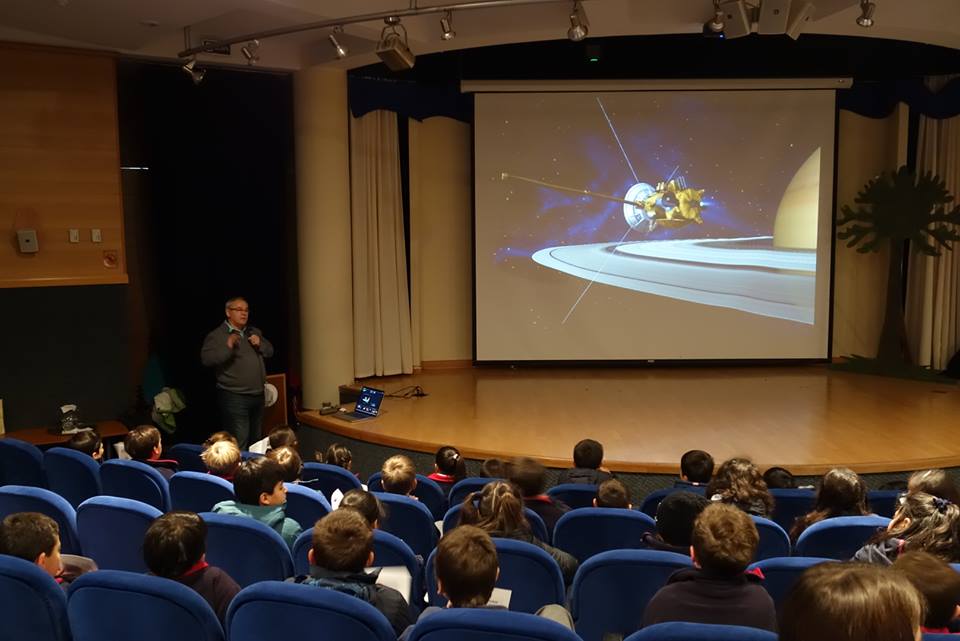 Our Instituto de Fisica y Astronomía, IFA, participated in the Semana de la Ciencia del Colegio SEK of Concón, with three talks given by Radostin Kurtev and Jordanka Borissova, both professors adn investigators from IFA, and the Masters Astrophysics Program student, Vicente Villanueva. October 14 and 15 permitted students from that school to learn about astronomy, through fascinating topics: Star Clusters (Dra Borissova), Cosmology (Vicente Villanueva) and a Unforgettable Journey to the Confines of the Universe in which Dr. Kurtev awakened the smaller ones´ curiosity regarding the unfathomable Universe. No doubt these talks awakened in them all an interest for this fascinating science.
Our Instituto de Fisica y Astronomía, IFA, participated in the Semana de la Ciencia del Colegio SEK of Concón, with three talks given by Radostin Kurtev and Jordanka Borissova, both professors adn investigators from IFA, and the Masters Astrophysics Program student, Vicente Villanueva. October 14 and 15 permitted students from that school to learn about astronomy, through fascinating topics: Star Clusters (Dra Borissova), Cosmology (Vicente Villanueva) and a Unforgettable Journey to the Confines of the Universe in which Dr. Kurtev awakened the smaller ones´ curiosity regarding the unfathomable Universe. No doubt these talks awakened in them all an interest for this fascinating science.
Associated link: Facebook Colegio SEK, Concón, V Region of Chile
October 19, 2015 IFA News
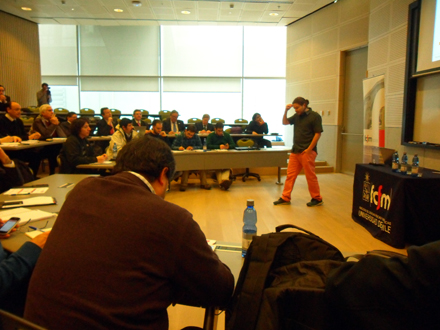 Professors Eduardo Ibar and Omar Cuevas attended, on behalf of the Instituto de Física y Astronomía, to the "Workshop en Desarrollo y Uso de Tecnología Espacial" organized by the "Consejo de Ministros para el Desarrollo Espacial". In this workshop, academics and investigators from various Universities got together to organize efforts with the aim to analyse and generate strategies for the Chilean development of Space. Present at this event was Pedro Huichalaf, Subsecretary for Telecommunications, who broached this subject with all those present. The "Workshop en Desarrollo y Uso de Tecnología Espacial" was sponsored by the Consejo de Ministros para el Desarrollo Espacial, Conicyt-Fondecyt and the Departamento de Ingeniería Eléctrica y la Facultad de Ciencias Físicas y Matemáticas de la U. de Chile. Also present were members of the Santa María University, Universidad Austral de Chile, Universidad de Valparaíso, Universidad de Concepción, Universidad de La Serena, Universidad de Talca, Universidad de Magallanes and the Universidad de Santiago.
Professors Eduardo Ibar and Omar Cuevas attended, on behalf of the Instituto de Física y Astronomía, to the "Workshop en Desarrollo y Uso de Tecnología Espacial" organized by the "Consejo de Ministros para el Desarrollo Espacial". In this workshop, academics and investigators from various Universities got together to organize efforts with the aim to analyse and generate strategies for the Chilean development of Space. Present at this event was Pedro Huichalaf, Subsecretary for Telecommunications, who broached this subject with all those present. The "Workshop en Desarrollo y Uso de Tecnología Espacial" was sponsored by the Consejo de Ministros para el Desarrollo Espacial, Conicyt-Fondecyt and the Departamento de Ingeniería Eléctrica y la Facultad de Ciencias Físicas y Matemáticas de la U. de Chile. Also present were members of the Santa María University, Universidad Austral de Chile, Universidad de Valparaíso, Universidad de Concepción, Universidad de La Serena, Universidad de Talca, Universidad de Magallanes and the Universidad de Santiago.
Associated link: http://espacial.subtel.cl/workshop-en-desarrollo-y-uso-de-tecnologia-espacial-en-chile/ -- http://www.actualidadespacial.cl/reunion_espacial_chile.html
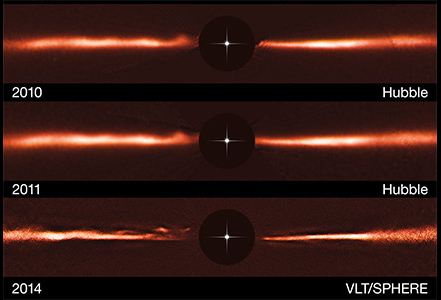 October 8, 2015 IFA News
October 8, 2015 IFA News
Dr. Johan Olofsson, an IFA postdoc, forms part of a team of investigators whose paper "Fast-Moving Structures in the Debris Disk Around AU Microscopii” was published in Nature Magazine on October 8, 2015. The work, using images f ESO’s Very Large Telescope and the NASA/ESA Hubble Space Telescope, astronomers shows never-before-seen structures within a dusty disc surrounding a nearby star. The fast-moving wave-like features in the disc of the star AU Microscopii are unlike anything ever observed, or even predicted, before now. The origin and nature of these features present a new mystery for astronomers to explore. AU Microscopii lies just 32 light-years away from Earth. The disc essentially comprises asteroids that have collided with such vigour that they have been ground to dust. The edge-on view of the disc complicates the interpretation of its three-dimensional structure. In the image, the top row shows a Hubble image of the AU Mic disc from 2010, the middle row Hubble from 2011 and the bottom row VLT/SPHERE data from 2014. The black central circles show where the brilliant light of the central star has been blocked off to reveal the much fainter disc, and the position of the star is indicated schematically.
Associated links: Nature Magazine Publication
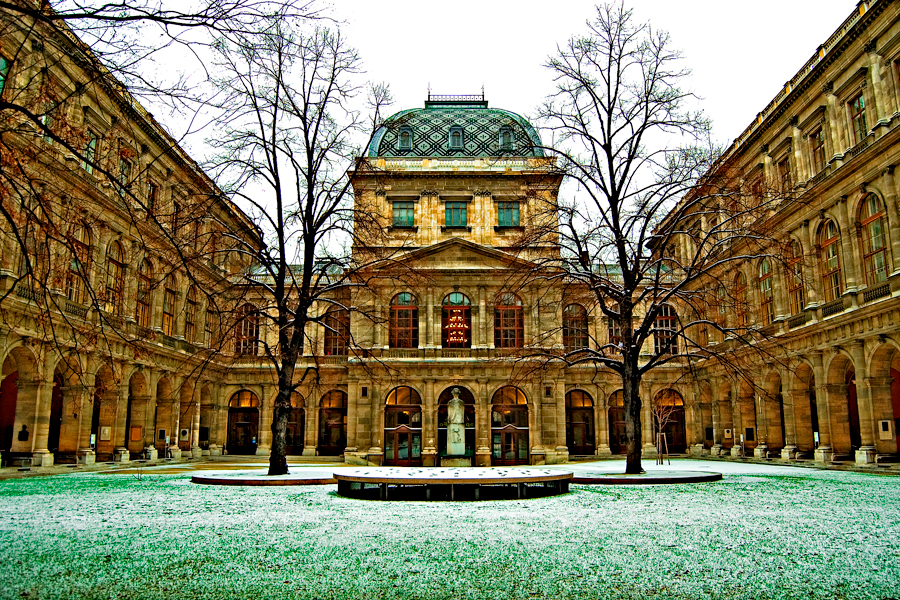 October 8, 2015 IFA News
October 8, 2015 IFA News
The Instituto de Física y Astronomía de la Universidad de Valparaiso, represented by its Director (s) Matthias Schreiber and the Universidad de Viena, represented by Professor Joao Alves´ Group, are working on an agreement for an Exchange Program for students of both universities with the aim to them undertaking part of their thesis work abroad, and for the establishing of short stays for investigators.
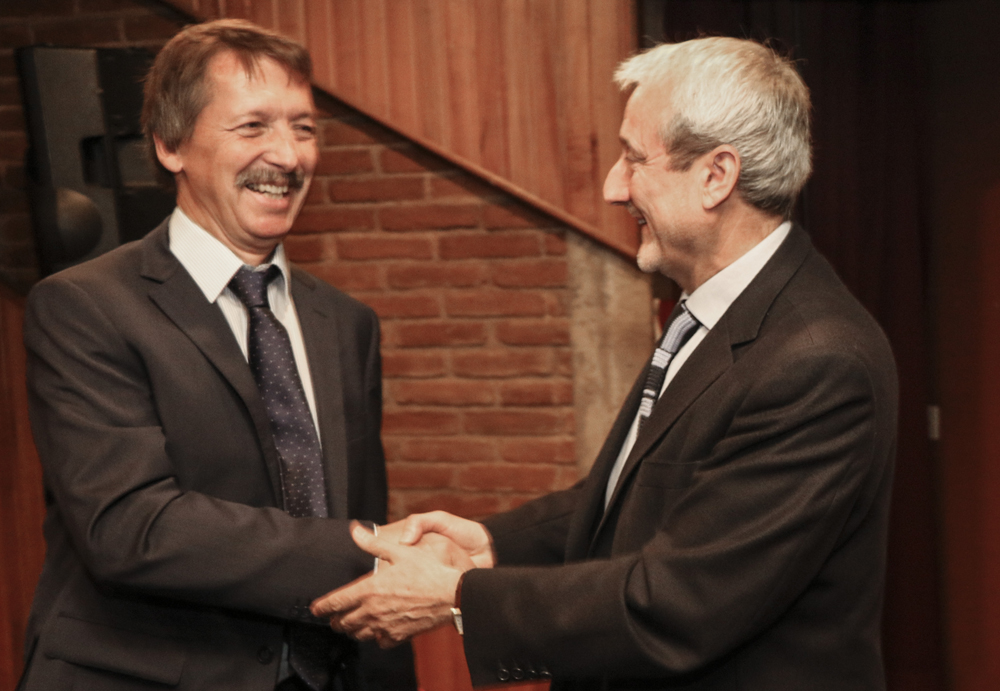 October 6, 2015 IFA News
October 6, 2015 IFA News
On friday October 2, IFA celebrated a collaborative agreement with the Max Planck Institut for Astronomie (MPIA), constituting, in words of Dr. Matthias Schreiber, Director of the PhD Program in Astrophysics, a "quantum leap" in the history of the Instituto de Física y Astronomia of the Facultad de Ciencias of the U. de Valparaíso. By this act a collaboration was initiated between the Max Planck Institut for Astronomie (MPIA) with base in Heidelberg, Germany, and the Universidad de Valparaíso, creating the first Tandem Group in Astronomy and thereby becoming a pole for world astronomy, to be installed in IFA at the beginning of 2016. The collaborative agreement was signed in the Sala Musicámara of the Dirección de Extensión y Comunicaciones of the UV, presided by the Rector, Aldo Valle, together with the Director for the Max Planck Institut for Astronomy, Dr. Thomas Henning. Present at the event also were the Dean for the Facultad de Ciencias, Dr. Juan Kuznar, the Director (s) for the IFA and Director to the PhD Program in Astrophysics, Dr. Matthias Schreiber, the Secretary General for the UV, Osvaldo Corrales, as well as academics, investigators, postdocs, undergraduate and postgraduate students.
Associated links: La Estrella de Valparaíso - Primero Valparaíso - Mar y Cordillera TV.com
 September 24, 2015. IFA News
September 24, 2015. IFA News
Many professors, post-docs and students belonging to the Instituto de Física y Astronomía - IFA will be giving astronomy talks during the month of October in support of the Explora Project "1000 científicos, 1000 aulas" covering subjects like astrostatistics, galactic and extragalactic astronomy, in the cities of Viña del Mar, Calle Larga (IV Region) and Antofagasta (II Region), with suggestive titles like "¿How can we learn about stars?" In this way IFA renews its compromise with outreach in science and incentivating the next generations of scientists.
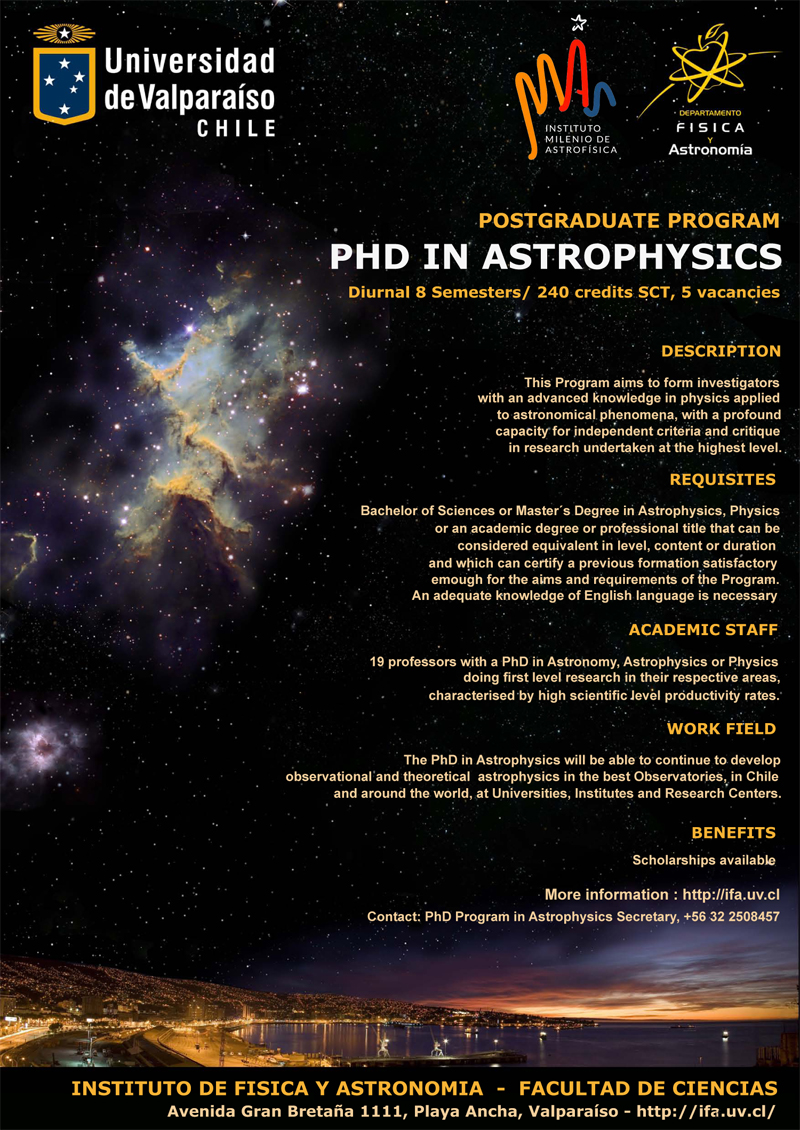 Agosto 28, 2015. Noticia IFA
Agosto 28, 2015. Noticia IFA
El Instituto de Física y Astronomia se complace en anunciar que con fecha 26 de agosto 2015, la Comisión Nacional de Acreditación CNA acordó acreditar el Programa de Doctorado en Astrofísica por un periodo de tres años. El Programa, dictado por nuestra Universidad, tiene como Director al Dr. Matthias Schreiber. Este importante logro de acreditación por el máximo periodo posible para una etapa temprana en un Programa, es resultado del trabajo intenso de los Drs. Eduardo Ibar, Patricia Arévalo y Alfredo Vega, en colaboración con la Dirección de Gestión de la Calidad y la Dirección de Postgrado. Este logro se suma a la acreditacion del Magister en Astrofisica por siete años, tambien el maximo periodo posible.
August 18, 2015. IFA News
On sunday August 16, the third version of the Escuela de Data Science de La Serena organized by REUNA commenced, in which students from all over the world (mainly chileans and northamericans) have the opportunity of establishing direct contact with one of the subjects of major proyection within the applied sciences: advances in knowledge by efficient use of great data bases. In this case, with applications mainly related to astronomy (but with parallel subjects related to industry). In its third version, the school received around 200 applicants to a total of ~35 vacancies, making it a success from the beginning. This school prepares undergraduate students and those embarking on postgraduate studies for facing current day problems, applying state of the art techniques in fields like automatic classification, etc. It has an unusual and equilibrated distribution between talks given by professors and direct work in multidisciplinary workgroup projects (the students mainly come from three fields: computing, mathematics and statistics and physics and astronomy). Our Investigator from the Instituto de Fisica and Astronomia, Patricia Arevalo, forms part of the core nucleus of professors for this school, and one of our undergraduate students from the Licenciatura en Física Mención Astronomía was chosen to participate.
Interesting information about the areas covered by the school:
- computing, statistics and astronomy
- 45% chileans, 45% northamericans, 10% from the rest of the world
- combination of projects and classes
The school is sponsored by AURA, LSST y NOAO, and relies on financing from the National Science Foundation (NSF). In Chile it is backed by the Centro de Modelamiento Matemático de la Universidad de Chile (CMM-UChile), the Instituto del Milenio de Astrofísica (MAS), the Universidad de La Serena and REUNA, as well as CONICYT.
The students visited the Santuario de la Oscuridad near Pisco Elqui, event covered by chilean television Channel 13. The sanctuary corresponds to the location where Gabriela Mistral, our Nobel Prize for Literature was laid to rest.
Julio 23, 2015. Noticia IFA
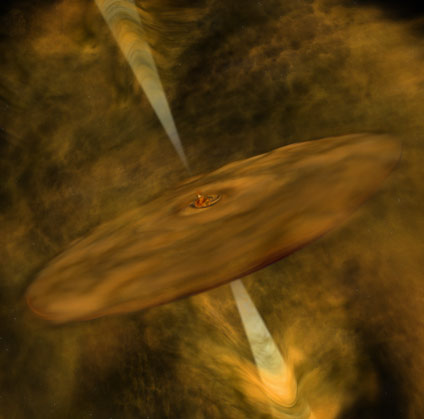 La Investigadora del Instituto de Física y Astronomía, IFA, Dra. Amelia Bayo, es miembro del equipo que realizó la publicación de la primera detección de chorros de material ejectados por proto-enanas cafe. Esta fenomenología similar a la de las proto-estrellas ("proto" siendo terminología que se refiere a los primeros estadios de formación de estos cuerpos celestes), confirma una vez más que las enanas café comparten su orígen con las estrellas, al menos en regiones poco densas como lo es la región de Tauro donde los chorros de material eyectados por esta proto-enana café han sido detectados. Créditos imagen: Bill Saxton, NRAO/AUI/NSF, concepcion artística de una enana cafe muy joven aun en formación con un disco de material que lo orbita, y jets de material eyectados hacia afuera desde los polos del disco.Enlaces asociados: Press Release de la NRAO (National Radio Astronomy Observatory) - Paper Científico en ADS (SAO/NASA Astrophysics Data Systems.
La Investigadora del Instituto de Física y Astronomía, IFA, Dra. Amelia Bayo, es miembro del equipo que realizó la publicación de la primera detección de chorros de material ejectados por proto-enanas cafe. Esta fenomenología similar a la de las proto-estrellas ("proto" siendo terminología que se refiere a los primeros estadios de formación de estos cuerpos celestes), confirma una vez más que las enanas café comparten su orígen con las estrellas, al menos en regiones poco densas como lo es la región de Tauro donde los chorros de material eyectados por esta proto-enana café han sido detectados. Créditos imagen: Bill Saxton, NRAO/AUI/NSF, concepcion artística de una enana cafe muy joven aun en formación con un disco de material que lo orbita, y jets de material eyectados hacia afuera desde los polos del disco.Enlaces asociados: Press Release de la NRAO (National Radio Astronomy Observatory) - Paper Científico en ADS (SAO/NASA Astrophysics Data Systems.
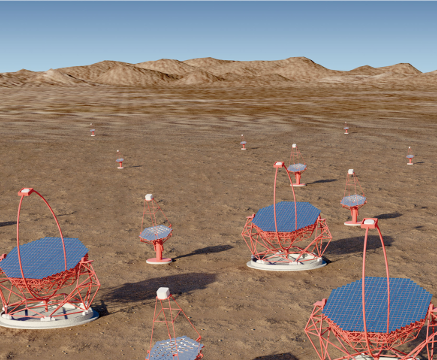 Julio 23, 2015. Noticia IFA
Julio 23, 2015. Noticia IFA
Chile, que recientemente fue aceptado como parte del consorcio multinacional que forma el "Cherenkov Telescope Array", el telescopio de rayos gama mas poderoso del mundo, ahora ha sido elegido como sitio para su construcción. El equipo chileno en CTA esta formado por científicos de la PUC, UChile, U. de Concepción, CECS, UCN, UNAB y la Universidad de Valparaíso. En el hemisferio norte, se eligió un sitio en el Observatorio La Palma en España, y en el hemisferio sur, en un sitio cercano al Observatorio Paranal.
Enlaces asociados:
.- Chile y España han sido elegidos para la instalación de la nueva generación de Observatorios Rayos Gamma.
.- La noticia, ahora en la prestigiosa Revista Nature
.- Noticia anterior con mas detalles sobre participación de nuestra Universidad en este proyecto
June 30, 2015 IFA News
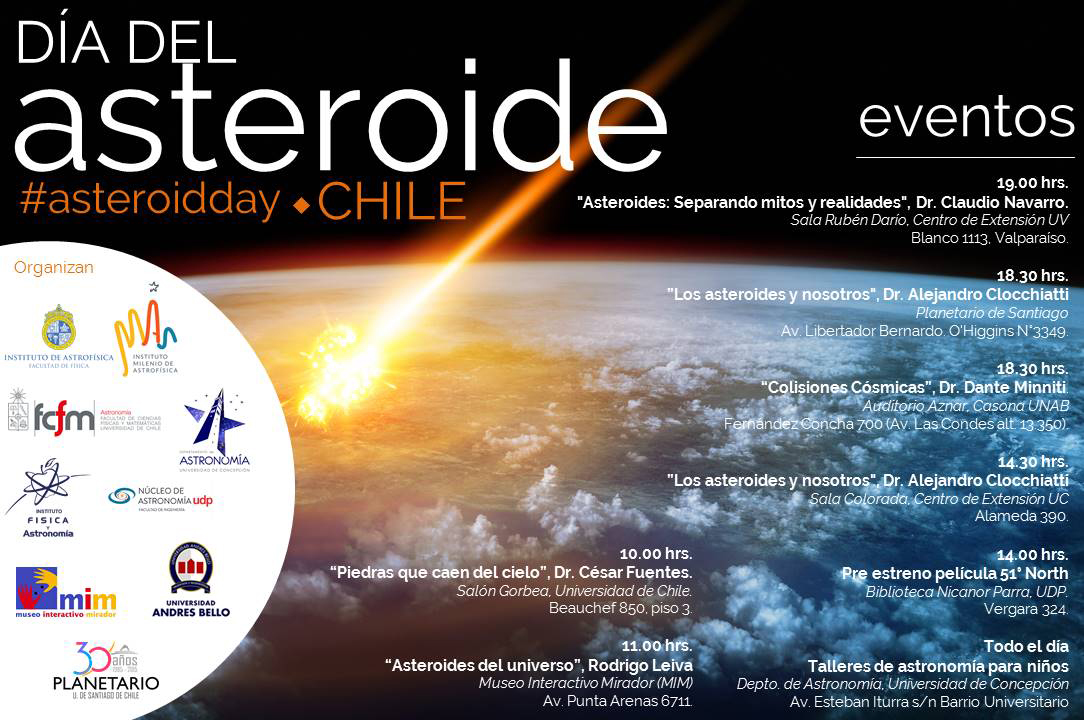 El Instituto de Física y Astronomía participa en la celebración del Dia Internacional del Asteroide a través de una charla que será dictada el 30 de Junio próximo en el Centro de Extensión de la U. de Valparaíso será dictada por Claudio Navarro, candidato a Doctorado en Astrofísica del IFA.
El Instituto de Física y Astronomía participa en la celebración del Dia Internacional del Asteroide a través de una charla que será dictada el 30 de Junio próximo en el Centro de Extensión de la U. de Valparaíso será dictada por Claudio Navarro, candidato a Doctorado en Astrofísica del IFA.
Encabezados por el Instituto Milenio de Astrofísica MAS y el Instituto de la Astrofísica de la Universidad Católica (IA), nueve instituciones chilenas se unieron para conmemorar este día organizando charlas, talleres, e incluso un estreno cinematográfico, en distintas zonas de Santiago, Valparaíso y Concepción.
Hace 107 años, en 1908, un asteroide de unos 35 metros de diámetro colisionó con la Tierra en la remota región rusa de Tunguska arrasando con una superficie de más de 2.000 km2. 107 años atrás la humanidad tuvo suerte, ya que esa zona era poco poblada, pues si el asteroide hubiera cruzado la órbita de la Tierra sólo unas cinco horas más tarde, podría haber impactado grandes ciudades como San Petersburgo, Helsinki, Tallin o Estocolmo, dejando innumerables daños. Ese evento es el que se conmemora globalmente por primera vez este 30 de junio, celebración liderada por el astrofísico y guitarrista de la banda Queen Brian May y que busca concientizar a la población sobre el peligro de que un asteroide potencialmente peligroso vuelva a chocar la Tierra. Este evento mundial, que incluye astrónomos, astronautas, geofísicos, escritores, artistas y realizadores cinematográficos, será conmemorado también por nueve instituciones nacionales las que realizaran charlas y talleres astronómicos en diversos puntos de la capital, además de Valparaíso y Concepción, las que incluso incluirán el pre estreno mundial 51° North, la cinta que inspiró la realización de este día a nivel global. “Socializar este iniciativa a nivel mundial es una buena noticia, que busca llamar la atención sobre un problema potencialmente peligroso para la humanidad. Paradójicamente, a diferencia de terremotos o tsunamis para los que no tenemos capacidad de predicción a largo plazo, este es un problema que estudiado en detalle podría solucionarse por completo”, explica Alejandro Clocchiatti, investigador del MAS y de la UC, precursor de esta celebración en Chile. Según explica el astrofísico, datos recientes de la NASA indican que cada 13 días tenemos impactos de asteroides mayores que un metro, una vez al año con algunos más grandes que un auto y aproximadamente una vez por década con piedras de 20 metros o más. De hecho, recién en febrero de 2013, nuevamente en Rusia, en la ciudad de Chelyabinsk estalló uno a 20 kilómetros de altura liberando casi medio megatón (30 veces la energía de la bomba de Hiroshima) causando más de 1.500 heridos y millones de dólares en pérdidas. Sin embargo, la idea de este día no es alarmar, sino tomar conciencia de este peligro y actuar antes de lamentar. “Los astrónomos sabemos que existen aproximadamente un millón de asteroides en el Sistema Solar con potencial para causar daños considerables en la Tierra. Nos falta encontrar todavía un 99% de ellos. Si uno descubre el asteroide que tiene trayecto de colisión con la Tierra en algún momento del futuro puede diseñar respuestas. Éstas pueden ir desde la evacuación de la zona de impacto para evitar muertes y lesiones, a la intervención sobre el asteroide en su órbita, previa al impacto, para provocar un cambio en la órbita y evitar la colisión. Hay propuestas muy variadas e ingeniosas para sacar a un asteroide del curso de colisión con la Tierra”, concluye Clocchiatti. El primer Día del Asteroide en Chile es organizado por el Instituto Milenio de Astrofísica MAS y el Instituto de la Astrofísica de la Universidad Católica (IA) junto con el Departamento de Astronomía de la Universidad de Chile, de la Universidad de Concepción y de la UNAB, el Instituto de Física y Astronomía de la Universidad de Valparaíso, el Núcleo de Astronomía de la Universidad Diego Portales, el Planetario de Santiago y el Museo Interactivo Mirador. Todas las actividades son gratuitas, previa inscripción.
Inscripciones a la Charla en Valparaíso (gratuito):
Centro de Extensión de la UV, Errázuriz 1108. Valparaíso
Escribir a This email address is being protected from spambots. You need JavaScript enabled to view it.
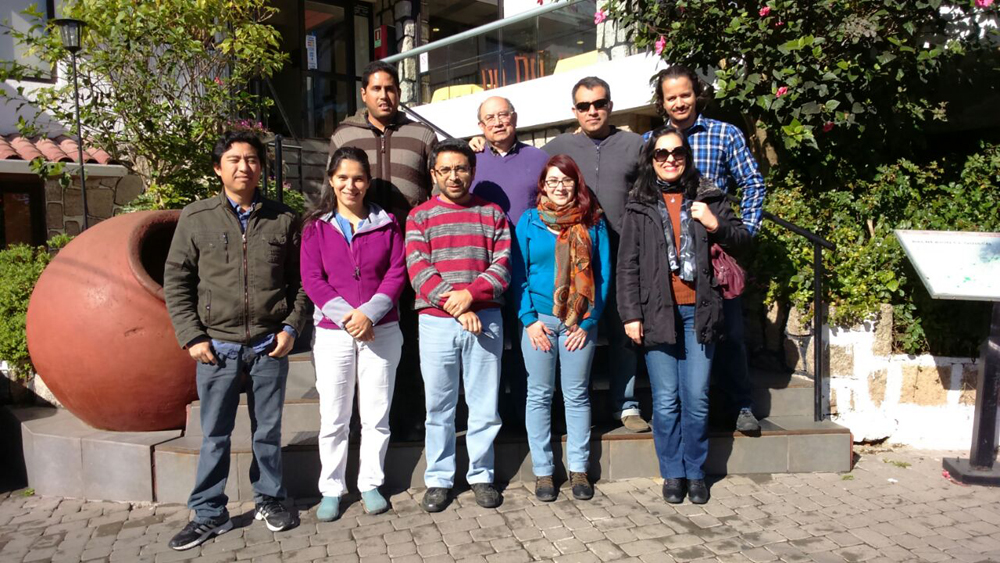 Our Instituto de Física y Astronomía participated in the "Second Workshop in Astrophysics Cosmology and Gravitation" that brought together experts in this area, coming form the following institutions: Universidad de Bio-Bio, Universidad de Tarapaca, Pontificia Universidad Catolica de Valparaiso and Universidad de Valparaíso. The event was held May 27-29, in the city of El Quisco, V Region.
Our Instituto de Física y Astronomía participated in the "Second Workshop in Astrophysics Cosmology and Gravitation" that brought together experts in this area, coming form the following institutions: Universidad de Bio-Bio, Universidad de Tarapaca, Pontificia Universidad Catolica de Valparaiso and Universidad de Valparaíso. The event was held May 27-29, in the city of El Quisco, V Region.
Los dias 4 y 5 de Mayo 2015 se realizó la Semana de la Inducción 2015A con la finalidad de invitar a los alumnos del Doctorado en Astrofísica a conocer todos los aspectos relacionados con sus estudios formales. Puede examinar el programa realizado ambos dias con mayor detalle en Semana Inducción 2015.
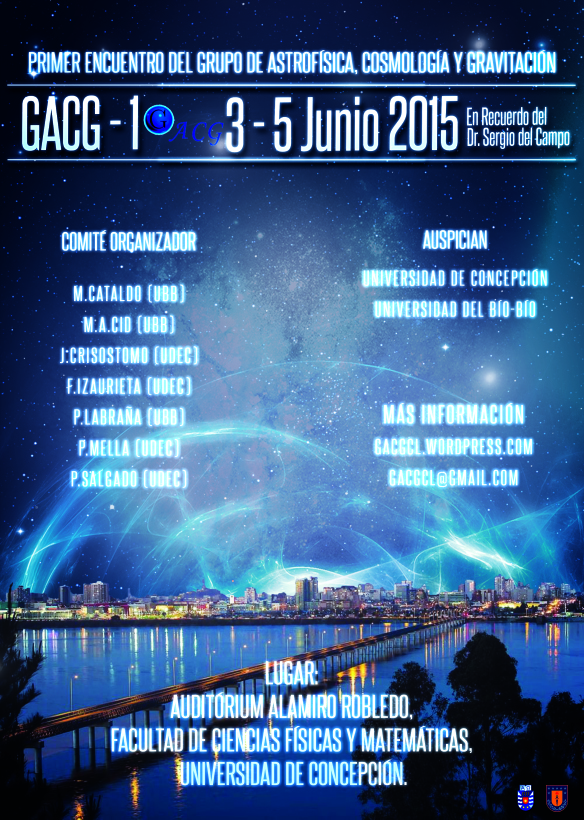 Mayo 5, 2015. Noticia IFA
Mayo 5, 2015. Noticia IFA
El profesor e investigador Dr. José Villanueva participó como Expositor en representación de nuestro Instituto de Física y Astronomía en el Encuentro GAGC, "Grupo de Astrofísica, Gravitación y Cosmología", en el cual además se recordó sensiblemente a quien fuera su profesor guía, Dr. Sergio Del Campo, QEPD. El evento se realizó entre el 3 y el 5 de Junio recien pasados en la Facultad de Ciencias Físicas y Matemáticas de la U. de Concepción. Enlace asociado: Programa del Encuentro del Grupo Astrofísica, Gravitación y Cosmología.
 May 11, 2015. IFA News
May 11, 2015. IFA News
The Universidad de Valparaíso together with a group of Chilean Universities, has joined the Consorcio Internacional CTA (Cherenkov Telescope Array) through its investigators from the Instituto de Física y Astronomía, Omar Cuevas, Alfredo Vega, Jose Villanueva and Víctor Cárdenas. Other memebers of this group are Diana Pozo y Julio Marín from the Departamento de Meteorología of the U. de Valparaíso. See more information: La Tercera Newspaper
April 23, 2015. IFA News
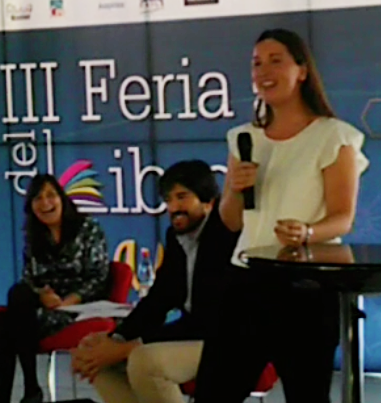 On thursday last, April 23, during the "III Feria del Libro de Beauchef" of the Facultad de Ciencias Fisicas y Matemáticas de la Universidad de Chile, Editorial Universitaria launched the book "Agujeros Negros en el Universo". One of its three authors, Dra. Patricia Arévalo professor and investigator at our Instituto de Física y Astronomía of the U. de Valparaíso, talked about how the book was conceived and undertaken, including some lovely anecdotes in this experience of taking astronomy to the general public in a scientific and approachable way.
On thursday last, April 23, during the "III Feria del Libro de Beauchef" of the Facultad de Ciencias Fisicas y Matemáticas de la Universidad de Chile, Editorial Universitaria launched the book "Agujeros Negros en el Universo". One of its three authors, Dra. Patricia Arévalo professor and investigator at our Instituto de Física y Astronomía of the U. de Valparaíso, talked about how the book was conceived and undertaken, including some lovely anecdotes in this experience of taking astronomy to the general public in a scientific and approachable way. 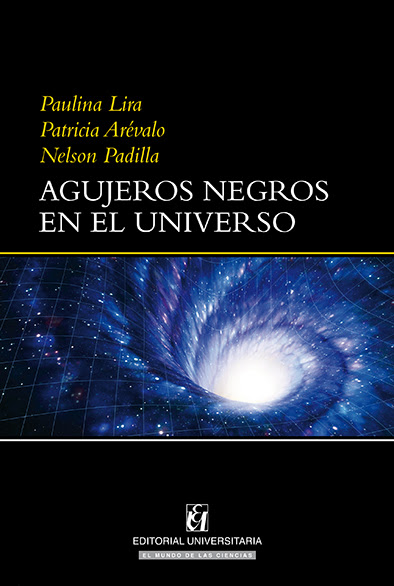 The authors remembered Carl Sagan, astronomer and public figure regarding outreach in astronomy, and who is no longer among us, who lead the way in this type of endeavour. The other co-authors are Dr. Paulina Lira (Departamento de Astronomia de la Universidad de Chile) and Dr. Nelson Padilla (Instituto de Astrofisica, Pontificia U. Catolica de Chile). The book may be acquired at Salón de Ventas in Alameda 1050 - Casa Central Universidad de Chile - Santiago. Telephone: (56)-2- 2896 89 60 This email address is being protected from spambots. You need JavaScript enabled to view it.. Image: Patricia Arévalo speaking beside coauthors Paulina Lira and Nelson Padilla.
The authors remembered Carl Sagan, astronomer and public figure regarding outreach in astronomy, and who is no longer among us, who lead the way in this type of endeavour. The other co-authors are Dr. Paulina Lira (Departamento de Astronomia de la Universidad de Chile) and Dr. Nelson Padilla (Instituto de Astrofisica, Pontificia U. Catolica de Chile). The book may be acquired at Salón de Ventas in Alameda 1050 - Casa Central Universidad de Chile - Santiago. Telephone: (56)-2- 2896 89 60 This email address is being protected from spambots. You need JavaScript enabled to view it.. Image: Patricia Arévalo speaking beside coauthors Paulina Lira and Nelson Padilla.
Associated link: http://www.universitaria.cl/
Abril 24, 2015 Noticias IFA.
 "El Hubble es un telescopio que hizo historia en la astronomía. Vino a revolucionarla. Al principio se pensaba que iba a funcionar entre 15 a 20 años, pero todavía lo hace. Es una tremenda contribución, es inimaginable su aporte, porque observa desde fuera de la atmosfera, por lo tanto puede capturar imágenes en un rango mucho más amplio que la longitud de onda y además al no tener atmósfera las imágenes son mucho más nítidas. El Hubble para la época de los 90 era una cosa increíblemente moderna y por la calidad de la óptica era una cosa extremadamente avanzada", con estas palabras, el Dr. Radostin Kurtev, docente e investigador del Instituto de Física y Astronomía de la U. de Valparaíso, relata lo que han sido 25 años de astronomía en relación a este telescopio, unico en su tipo y que aportó y sigue aportando enormente al estudio de objetos en el espacio en la longitud de onda ultravioleta, ademas del óptico. Enlaces: vea la noticia completa en www.ucvradio.cl
"El Hubble es un telescopio que hizo historia en la astronomía. Vino a revolucionarla. Al principio se pensaba que iba a funcionar entre 15 a 20 años, pero todavía lo hace. Es una tremenda contribución, es inimaginable su aporte, porque observa desde fuera de la atmosfera, por lo tanto puede capturar imágenes en un rango mucho más amplio que la longitud de onda y además al no tener atmósfera las imágenes son mucho más nítidas. El Hubble para la época de los 90 era una cosa increíblemente moderna y por la calidad de la óptica era una cosa extremadamente avanzada", con estas palabras, el Dr. Radostin Kurtev, docente e investigador del Instituto de Física y Astronomía de la U. de Valparaíso, relata lo que han sido 25 años de astronomía en relación a este telescopio, unico en su tipo y que aportó y sigue aportando enormente al estudio de objetos en el espacio en la longitud de onda ultravioleta, ademas del óptico. Enlaces: vea la noticia completa en www.ucvradio.cl
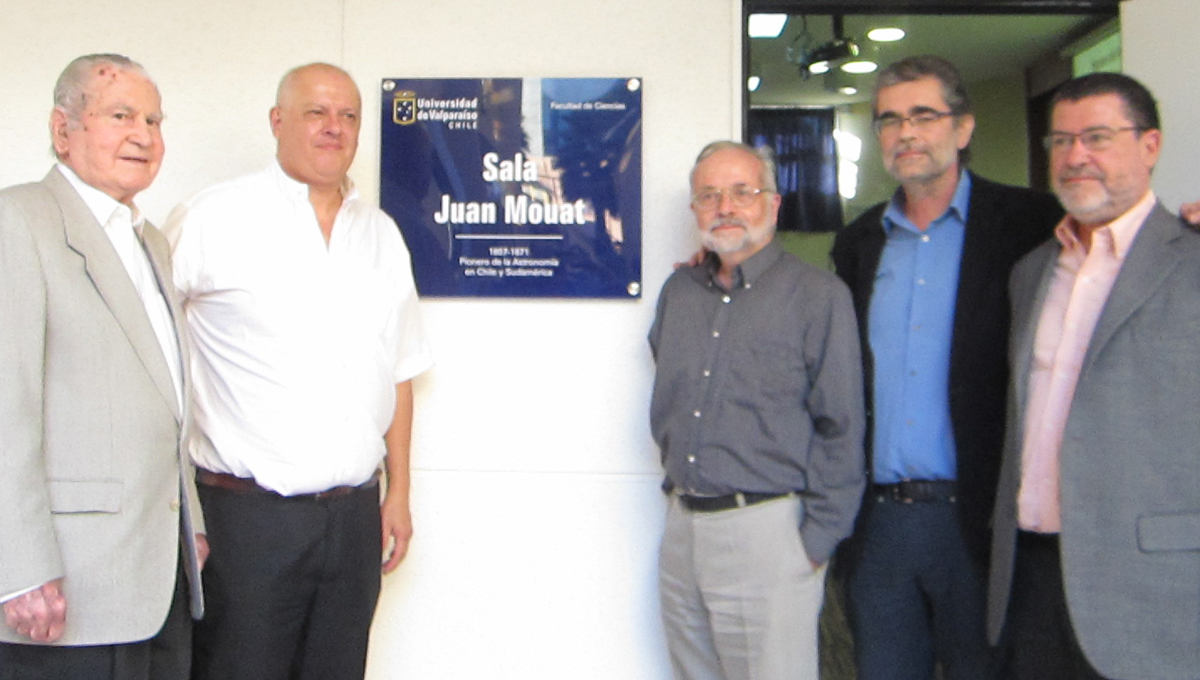 Abril 14, 2015-Noticia IFA
Abril 14, 2015-Noticia IFA
El jueves 9 de Abril de 2015 recien pasado, el Instituto de Fisica y Astronomía - IFA homenajeó a quien instaló el primer observatorio en las costas del Pacífico en América, un Valparaíso del año 1843. La Sala 11-A, en que hoy se dictan seminarios astrofísicos de excelencia para los investigadores y alumnos de postgrado del IFA, reaizados por investigadores nacionales e internacionales, se llamará en adelante, Sala Juan Mouat. Presentes también en la ceremonia, que reunió docentes, investigadores y alumnos de pregrado y postgrado del IFA, se encontraban sus descendientes, Sr. Victor Mouat (bisnieto, Médico Traumatólogo y co-fundador de la Clínica Las Condes), Sr. Francisco Mouat (Periodista) y el Sr. Leopoldo Infante (Cosmólogo de la Pontificia Universidad Católica de Chile), estos dos ultimos, tataranietos de este pionero de la astronomía amateur en Chile. Francisco Mouat dedicó algunas emotivas palabras durante la ceremonia para resaltar algunas características de su antepasado, entretejiendola con poesía y recuerdos de esa época. En la imágen, la placa con el nombre de nuestra Sala Juan Mouat. En la imágen, de izquierda a derecha, Victor Mouat (bisnieto), Dr. Michel Curé (Director Instituto de Fisica y Astronomía, Dr. Nikolaus Vogt (gestor de la iniciativa), Francisco Mouat y Leopoldo Infante.
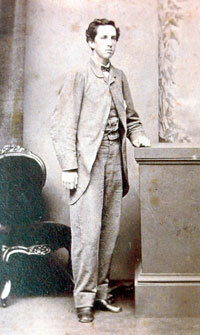 Juan Mouat Walters (1809-1871) relojero y óptico de profesión compró el terreno donde antiguamente se inssaló el antiguo Castillo San José (actual Museo Lord Cochrane) lugar en el cual, dos años mas tarde, 1843, instalaría el Primer Observatorio Astronómico en Chile, a pocos dias de la aparición del gran cometa de 1843 (luego denominado 1843 I y C/1843). Multifacético personaje del siglo 19 dedicó su vida a varios proyectos, entre ellos obtener la concesión para la construcción del ferrocarril entre Copiapó y Caldera (era además ingeniero), y formar parte, como fundador, del primer equipo de Bomberos de Valparaíso. Fallece el año 1871 en Valparaíso.
Juan Mouat Walters (1809-1871) relojero y óptico de profesión compró el terreno donde antiguamente se inssaló el antiguo Castillo San José (actual Museo Lord Cochrane) lugar en el cual, dos años mas tarde, 1843, instalaría el Primer Observatorio Astronómico en Chile, a pocos dias de la aparición del gran cometa de 1843 (luego denominado 1843 I y C/1843). Multifacético personaje del siglo 19 dedicó su vida a varios proyectos, entre ellos obtener la concesión para la construcción del ferrocarril entre Copiapó y Caldera (era además ingeniero), y formar parte, como fundador, del primer equipo de Bomberos de Valparaíso. Fallece el año 1871 en Valparaíso.
March 5, 2015-IFA Newsticia IFA.
Amelia Bayo, professor and investigator of IFA will partiicpate in Puerto de Ideas Antofagasta 2015, an event which brings together scientists who undertake outreach, in a meeting charaterized by reflections, curiosity and investigation in science in Chile and Latinamerica
Talking about science can be fun - Scientific Outreach Dialogues
¿Why not do science and have fun at the same time? ¿Erudition and entertainment? ¿Why do we assume that science is only for specialists? Science forms part of our daily lives. Apples fall on people´s heads due to something appparently complex yet as simple as the force fop gravity. Two persons cannot bathe together in the same full bathtub without wreaking havoc, if we take into account Archimedes Principle or that of hydrostatic push.
In an attempt to apporach science in a new way, “Stand up Comedy Científico” will be developed by a team from the Centro Cultural de España, the dramaturg Jesús Codina and actors Carola Paulsen and José Martínez, around scientific proposals belonging to Dr. Amelia Bayo and Chemist Dr. Marcelo Kogan, originated in the Festival de Cheltenham and wjhich is very popular today in Spain through FameLab.
Dr. Amelia Bayo, from the Instituto de Física y Astronomia of our University, has a PhD in Physics from the Universidad Autónoma de Madrid, Madrid. She is professor/Investigator of the Universidad de Valparaíso. Support astronomer at ESO´s Observatorio del Cerro Paranal in Chile. Specialist in: low mass stellar formation, disk evolution, substellar objects, Virtual Observatory and Astrostatistics.
Associated links: Puerto de Ideas Antofagasta 2015 - Invited to the Event
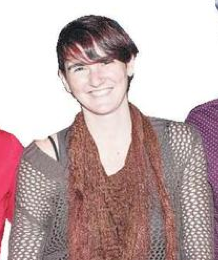 April 14, 2015-IFA News
April 14, 2015-IFA News
"Carcajadas científicas" es el nombre del stand up comedy que mostró de manera lúdica las investigaciones de la astrónoma Amelia Bayo y del químico Marcelo Kogan". The daily newspaper "El Mercurio de Antofagasta" tells us all about this event in its April 12 issue, which covers the participation of the investigator of our Instituto de Fisica y Astronomía, Dr. Amelia Bayo. (Image credits: El Mercurio de Antofagasta). Associated link: El Mercurio de Antofagasta



